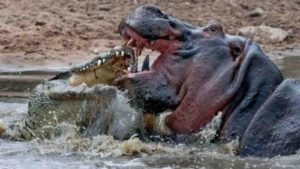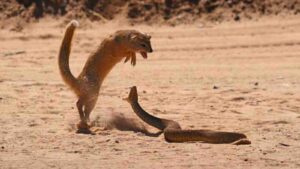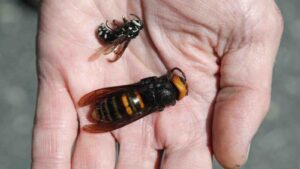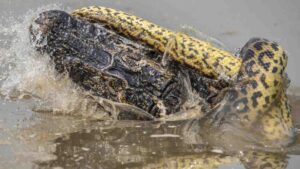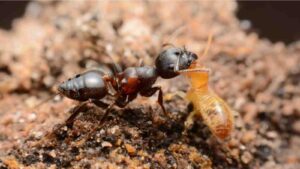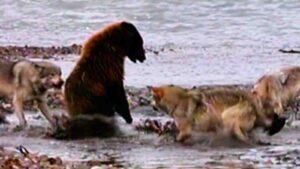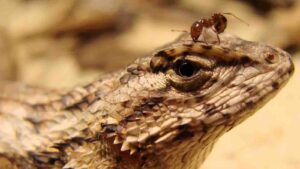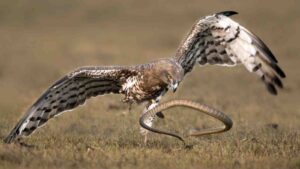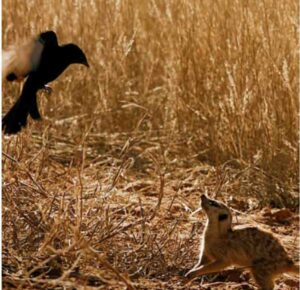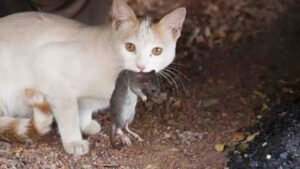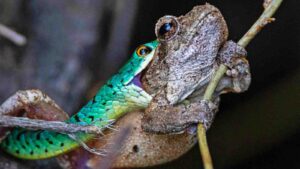Top 20 animals that hate each other
Summary
Top 20 animals that hate each other. Where there is love, hatred exists. Like humans, animals have a feeling of love and hatred as well. Animals can dislike each other for many reasons. Sometimes the level of hatred goes too […]

Top 20 animals that hate each other. Where there is love, hatred exists. Like humans, animals have a feeling of love and hatred as well. Animals can dislike each other for many reasons. Sometimes the level of hatred goes too much beyond the normal stage that journalists feel to record that video footage for days along. Here are the top 20 unbelievable animal hate stories.
Video: Top 20 animals that hate each other
Hippopotamus vs. Crocodile
The mass of one of the dominant male hippo is about the same as two football teams combined. Crocodiles have the most powerful bite force on the planet, and these two animals hate each other. In the dangerous waters of the South Luangwa channels, only 2% of crocodile hatchlings make it to adulthood.
The pairing is unusual because normally, crocodiles eat hippocalves, and hippos will usually only play within their species. The unlikely match doesn’t last too long. The croc gets its way when a herd of elephants come along and chase the hippo away.
Mongoose vs. Cobra
The Indian Grey Mongoose is somewhat immune to cobra bites and is very agile, so it can win in a fight with a cobra. However, the mongoose in the animal world will probably avoid the snake even though they’re stronger, as they eat lots of other animals and would rather not work so hard for their meal.
Snakes and mongooses—these animals hate each other as natural enemies because the mongoose has to kill the snake so the snake doesn’t kill the mongoose and the snakes have to kill mongooses so the mongooses don’t kill the snakes. Basically, they each need to kill the other to survive, so they kind of hate each other.
Video: Top 20 animals that hate each other
Polar Bear vs. Walrus
Polar bears are generally more dangerous on land, while the existence of walrus animals is more dangerous in the water. Walruses would prefer to haul out on sea ice, where they are somewhat safer from polar bear attacks. Likewise, polar bears would prefer to hunt on the sea ice for ringed seals, which are a much safer prey. Adult male polar bears will sometimes hunt walruses, but the smaller females, especially when malnourished, lack the strength necessary to take down the much larger predator.
Killer Whale vs. Great White Shark
No contest—the shark always flees. These hated animals—the great white shark and the killer whale or orca—are fearsome top predators. But of the two massive animals, the killer whale may be the more formidable one, a new study has found. The great white shark might have scarier teeth, but the killer whale is bigger and faster. Killer whales also have an advantage when hunting in big groups. A group of sharks had been swimming near the beach when a pod of orcas showed up.
Elephant vs. Rhinoceros
Elephants are much bigger and heavier. An adult bull elephant is on average 3.2 meters tall and weighs approximately 6 tons. The male white rhino seems small in comparison with an average height of 1.8 m and a weight of 2,300 kg. A rhino can run at up to 50 km/h. Male lions are effective killers: a single male can overpower a young elephant, and just two males could take down an adult. The elephants are highly aware of this reality; hence, they hate each other.
Honey Bee vs. Asian Giant Hornet
Western honey bees, the species that exist in the United States, have somewhat similar behavior, but they are not as effective as Asian honey bees. Instead, western honey bees appear to rely more on stinging, which is effective on smaller predator species. This makes it all the more important for beekeepers to maintain a healthy and large worker population so they can defend themselves. A full colony is a happier, healthier, and better-defended colony.
Crocodile vs. Anaconda
If they were really trying to help each other in the killing, the crocodile is still most likely to win. It’s bigger than anything the anaconda preys on and, in all likelihood, is too big for the anaconda’s method of attack to do any real damage to. On the other hand, the crocodile’s bite is more than enough to kill the snake. A green anaconda attacked the six-foot-long caiman in Pantanal, Brazil, after finding it in the swamps of tropical wetland, and the reptile later died.
Ants vs. termites
When these two hated animals go up against each other, it’s usually not even close to a fair fight. Termites get annihilated. Despite their average size and weight, ants are much more aggressive and almost always have numerical superiority as well.
Ants and termites require similar living habitats, making them natural competitors. Many species of both pests build nests underground. Like termites, carpenter ants also excavate wood. When ants eat termites, they benefit since they’re removing potential rivals for prime nesting sites.
Grizzly Bears vs. Wolf
Wolves and bears have never been allies. This video of a wolf pack attacking a mother grizzly and her cubs is proof. They’ll surplus kill, which means they’ll kill more animals than they can eat or cache at the time. They’ll also attack larger predators if their numbers make the attack effective.
Archerfish vs. Bug
The archerfish then spits a jet of water at its prey, with enough force to knock it off its perch and send it crashing into the water. That means dinnertime for the hungry archerfish and curtains for the luckless insect.
University in Winston-Salem, North Carolina, presented spotted archerfish with insect targets at different distances. The closest prey was 2.3 body lengths away, and the furthest was 5.8 body lengths away.
Fence Lizard vs. Fire Ants
Typically, once the ants lift a scale covering the skin to expose a lizard’s soft flesh, they inject neuromuscular venom into the skin that can paralyze and kill the lizard.
Amazingly the common, but invasive, Brown Anole Lizards living in the backyard have evolved to enjoy a treat of invasive fire ants, probably because they have been around together for many years now.
Read More: Top 20 wild animals’ people actually own
Eagle vs. Snake
Bald eagles are known for eating snakes. Though it is not their primary source of food, they are able to catch and eat one.
Although it is rare for a venomous snake to kill an adult eagle Eagles are not immune to the snake’s venom. And Eagle depends on a quick and sudden attack to grab the snake before it can bite it.
Lion vs. Hyenas
Lions are larger and stronger than hyenas. Hyenas outnumber lions and use their larger populations to compete with lions for food.
It is true that lions eat hyenas, but it isn’t a common thing. Lions end up killing hyenas to cut down the competition for food. Lions see hyenas and other apex predators as a threat to their territory and life, which explains why lions kill them. It is important to note that lions don’t kill hyenas to eat them.
Meerkats vs. Drongo Birds
Drongos, the cute animals common in southern Africa, usually get meals in an honest way, such as capturing insects in mid-air using their incredible aerial skills. But at other times, like on cold mornings when few insects are flitting around, the drongos turn to a life of crime.
When times are hard, the crafty bird can make false alarms to make other animals drop their kill and run from the scene. Meanwhile, the drone swoops in to pick up the remains. But sometimes the birds try this tactic too often, and when they don’t get a reaction, researchers have discovered they have another trick up their sleeves: vocal mimicry.
Wolf vs. Coyote
A gray wolf is much larger than a coyote. Wolves weigh 80 to 120 pounds, while coyotes weigh 20 to 50 pounds. Wolves have a broader, shorter snout, while coyotes have a narrow, more pointed nose. A wolf’s howl is long and drawn out, while a coyote produces a shorter, yapping sound.
Eighty to ninety percent of coyote deaths from wolves take place at kills, where Wily Coyote is not quite so sneaky and gets a little too close to his larger brethren. For other animals, this can be good news.
Rodents vs. cats
Tom and Jerry were entertaining; a cat chasing a mouse around probably wouldn’t be so fun. Just like cats could easily harm a bird, they could be deadly to a rodent, too. It’s a sense of smell, a sense of hearing, a sense of taste, and an instinct for ‘the chase’ that makes the fluffy kitty cat a well-oiled mouse-hunting machine. There’s no way to completely trust a cat around a rodent because you never know when that instinct will kick in.
Cats vs. dogs
We know, we know. Lots of people have cats and dogs. And typically it’s a tolerant, if not genuinely loving, relationship. However, some members of each species never get along and could actually end up becoming crazy animals by hurting the other. Hunting dog breeds obviously might want to hunt cats. And even herding dogs might drive a catnut trying to herd it around the house. Plus, a friendly but energetic dog trying to get a cat to play might get a nasty swipe from some cat claws.
Ferrets and birds
Just like they’ll hunt small mammals, ferrets will attack a pet bird—even a large parrot. Ferrets are sly and will find a way to wiggle into your parrot’s cage looking for a tasty meal. Therefore, to avoid a large vet bill, it’s best never to keep these animals together.
Hedgehogs vs. Porcupine
Hedgehogs have seen a rise in popularity as exotic pets. But they shouldn’t come into contact with any of your other small animals. For one thing—and this really should be a no-brainer—they’re sharp. They don’t release their quills like porcupines, but those pointy things can still do some damage, even to a much larger animal. But on the flip side, a curious cat or dog could seriously injure a hedgehog, too. Plus, as if the quills weren’t enough, hedgehogs carry bacteria that can sicken other species.
Read More: This is How Accident Helped Him to Grow Superpower
Snake vs. Frog
Snakes are often cool to pay a visit to the zoo, but there are several reasons to keep them separate from frogs. Snakes carry salmonella, according to the Centers for Disease Control and Prevention, which can infect frogs, including humans. Eventually, these two animals are being hated by humans. Additionally, snakes might attempt to prey upon birds as well.
Even different types of snakes aren’t suited to coexist. They have varying temperatures, diets, and light requirements, as well as conflicting behaviors. Also, some might naturally carry diseases that would infect a frog within a few minutes.
Which of them is the worst enemy ever? Let us know in the comment section.
